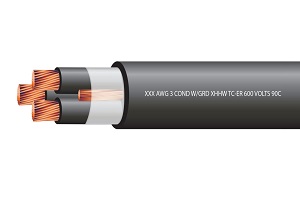Voltage rating is one of the most basic, fundamental ratings associated with electrical wire and cable, given in volts.

Voltage itself is a measurement of electrical potential, calculated by multiplying a given electrical current (in amperes, I), by the resistance of a conductor, (in ohms, Ω).
The material of the conductor, as well as the thickness, will all impact resistance. These things, being variables from which voltage is drawn, affect voltage rating.
Think of voltage as the force “pushing” the electricity through a wire or cable, similar to how plumbing pipes experience line pressure, except that line pressure is measured in PSI instead of volts.
Just like with water pipes, it is essential never to exceed the voltage rating of a given conductor - but instead of a burst pipe, exceeding the voltage rating of an electrical conductor can cause overheating, fires, and an elevated risk of dangerous electrical shock.
But what exactly is a wire’s voltage rating?
So, What Really Is 600 Volt Wire?
The voltage rating is the highest voltage that can be continuously applied to an electrical conductor in a sustained manner without the risk of overheating or circuit failure.
Voltage rating is calculated by accounting for Ohm’s Law, related to electrical resistance, and the Power Calculation Formula, which is related to power output.
Voltage rating is affected by the diameter of the wire, the electrical resistance of the material from which it is made, and the dielectric rating of the conductor’s insulation. All things being equal, the thicker the wire, the greater voltage it can tolerate. However, material and insulation can affect this, too.
It is critical never to exceed the posted voltage rating of an electrical conductor because it will cause the wire to overheat and increases the risk of electric shock.
Excess voltage can also be extremely destructive to sensitive electronic components and connections. Sustained, excessive voltage can cause them to melt or burn out.
What Is Voltage Drop?
Voltage drop is the natural loss of electrical potential of an electrical stream running through an electrical conductor, which is the product of the conductor’s length, thickness, and resistance.
Voltage drop is an undesirable condition that impacts the voltage supplied at one point of a given circuit. Electric Codes (such as the NEC) may be responsible for setting guidelines for the maximum voltage drop permitted in a circuit in order to ensure an efficient supply of power.
Where Can You Get High Quality 600 Volt Wire and Specialty Wire?
Looking for high-quality 600-volt wire, building wire, and other specialty electrical wire and cable? Visit EWCS Wire online at EWCSWire.com.
They carry a broad assortment of building wire, as well as wire and cable for a number of specialty applications, such as solar panel cable, battery leads, flexible welding cable, marine battery cable, tray cable, armored cable, fire alarm cable, and much more.
In addition to offering high-quality electrical wire and cable, EWCS Wire offers fast shipping as well as a customer satisfaction guarantee. For more information, visit their website via the link above or get in touch with them at 800-262-1598 or at Sales@EWCSWire.com.
Comments
Post a Comment